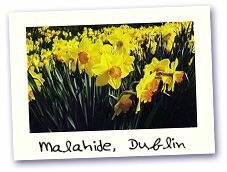 |
Search the site:

Malahide Castle Gardens, County DublinMost Irish gardens rely on ericaceous plants such as rhododendrons to provide their main displays of colour, but at Malahide these are largely precluded by the alkalinity of the soil (around pH 7). Prominence has thus been given to the many lime-tolerant genera so often bypassed in favour of more eye-catching plants. The scent from philadelphus, syringa, deutzia and old roses more than compensates for any lack of colour, while the enormous range of non-ericaceous plants at Malahide-one of the most impressive of its kind in these islands-is particularly admired for its collection of ceanothus, clematis, crocosmia, eryngium, escallonia, euphorbia, hebe, hypericum, olearia and pittosporum.
The gardens cover twenty acres, including a four-acre walled garden, and lie to the west and north of Malahide Castle. They form part of a 250-acre demesne park acquired by Dublin County Council in 1976 following the death of Lord Talbot de Malahide. The history of the Talbots at Malahide stretches back to the end of the twelfth century, but the gardens are the creation of Milo, the seventh Lord Talbot de Malahide-a noted plantsman who assembled a collection of over 5,000 species and cultivars between 1948 and 1973. Visitors approach the main garden ñ a varied mixture of trees and shrubs known as the West Lawn ñ from the front of the castle. Passing just beyond a blue conifer, Cupressus glabra 'Pyramidalis', the main focus of the garden layout comes into view on the left ñ a spacious lawn dominated by a large cedar with spreading cyclamen below. The main shrubberies, divided by a network of grass rides and interlinking paths, are to the right, while the avenue area, which also contains some rare and outstanding plants, lies on the opposite side of the lawn. The shrubberies are entered by a long tarmacadam path flanked by borders containing a variety of shrubs and herbaceous perennials, many noted for their fragrance as well as for their flowers. Among these are the Californian poppy (Romneya couteri), the large white-flowering Philadelphus 'Beauclerk', the honey-scented yellow Pittosporum eugenioides 'Variegatum', and the flowering quince Chaenomeles speciosa 'Vermillion'. Here also lies a large-leaved Meliosma dillineifolia, while off the grass rides to the north east stand several interesting trees, including an unusual variety of the strawberry tree (Arbutus unedo 'Rubra'), a very wide-spreading Pterocarya fraxinifolia and the rarely seen Aralia spinosa, known as the devil's walking stick because of its viciously spiny stems.
> > > Read the concluding part of this article From the Appletree Press title: Irish Gardens. |
All Material © 1999-2005 Irelandseye.com and contributors

 Close connections with Australia resulted in Australasian genera being particularly well represented, but Lord Talbot also had a fondness for South American plants and was a recognised authority on the genus Olearia-interests that are still reflected in the planting today.
Close connections with Australia resulted in Australasian genera being particularly well represented, but Lord Talbot also had a fondness for South American plants and was a recognised authority on the genus Olearia-interests that are still reflected in the planting today.